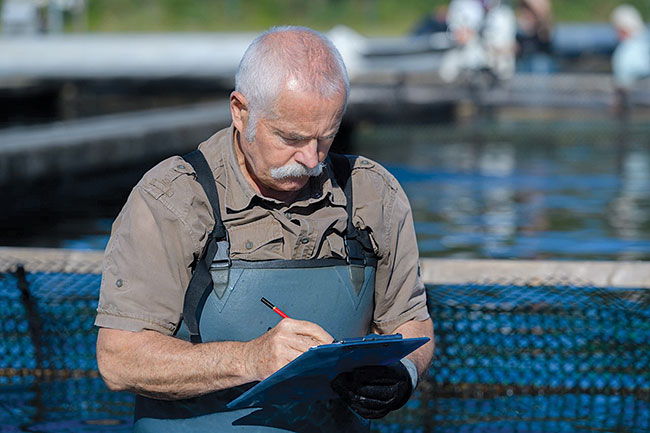
Surveys on fish farms make pandemic relief possible
January 26, 2022
By Arsenia King
 You think answering surveys is tedious? Think again. Data collected through surveys have helped the US aquaculture farmers receive much-needed government relief in times of crisis, says aquaculture economist Photo: © auremar / Adobe Stock
You think answering surveys is tedious? Think again. Data collected through surveys have helped the US aquaculture farmers receive much-needed government relief in times of crisis, says aquaculture economist Photo: © auremar / Adobe Stock Surveys on the impact of the COVID-19 pandemic on fish farmers and the farmers’ participation in those studies have helped US farmers receive much-needed government relief as the industry struggled with abrupt loses of sales, income, and opportunities during the period.
Dr. Carole Engle, author and a nationally recognized aquaculture economist in the US, said US fish farmers may not have had access to relief funds were it not for the efforts of individuals who pushed hard to generate systematic data documenting the losses incurred by US aquaculture farms during the pandemic.
“Aquaculture was not initially deemed eligible for many of these relief programs because there is insufficient data from US aquaculture compared to other forms of agriculture,” said Engle, who spoke at the plenary session of Aquaculture America 2021 held in San Antonio, Texas.
One of the grants Engle mentioned as having leveraged survey data was the Coronavirus Food Assistance Programs (CFAP 1 & 2) of the US Department of Agriculture Farm Service Agency (USDA-FSA), which provided direct relief to producers who faced price declines and additional marketing costs due to COVID-19. Most of the beneficiaries of the grant are agriculture farmers.

Aquaculture economist Dr Carole Engle says increased understanding of Aquaculture by the USDA should encourage community engagement
Engle related how Matthew Smith, program director from Ohio State University, decided early in the pandemic that a survey was needed to measure its effects on fish farms and how Jonathan van Senten of Virginia Polytechnical Institute and State University (Virginia Tech) designed and launched a national survey in record time. (Results of those surveys were published in Aquaculture North America as they were released.)
She also lauded the fish farmers’ willingness to send confidential and hard-to-obtain price and inventory information at the request of the National Aquaculture Association (NAA) for USDA-FSA to calculate accurate payments for affected farmers.
The government relief has been a lifeline for most farmers. Data derived on the performance of small to large and well-stablished farms during the pandemic has been gloomy. Ninety percent of respondents reported various impacts on their business: 80 percent reported loss of sales, 33 percent admitted to having laid off employees and 26 percent said they would do so, soon. In addition, nearly half of the respondents said they experienced other challenges beyond labor, such as difficulty obtaining inputs and supplies, repairs, and accessing financial services.
Opportunities to thrive
Despite the pandemic, Engle sees a brighter future for the industry as she believes there are opportunities to thrive if individuals involved in the industry commit to assisting and supporting fish farmers.
She believes the increased understanding of Aquaculture by the USDA should encourage engagement by the community in both federal and state levels to increase representation.
She also emphasized the importance of education and the use of science-based and research-based information to help farmers take advantage of opportunities that may have already been there.
For instance, she noted that disruption in supply chain has driven renewed emphasis on the importance of strengthening supply chain particularly for local food supplies to ensure food security and to meet emerging trends such as increase in home cooking or demand for recreational stocking.
Engle said everyone involved in the industry must be poised to exploit opportunities today while waiting for the pandemic crises to resolve.
She urged farmers to join and be active in aquaculture organizations, respond to requests for survey when asked, engage with state and federal agencies, and learn and prepare records needed to be eligible to relief and other programs.
Likewise, she encouraged researchers to join farmers organizations, listen to farmers and their problems and design research to address them. She cautioned against focusing only on trendy topics and limiting studies within the lab environment. “Test your work on actual farms and under commercial conditions,” she added.
Addressing extension specialists, Engle said they also needed to join farming organizations, listen to farmers, and design their extension program to tackle their needs. “Extension program is not just a matter of writing fact sheets, it is tacking problems and finding solutions which may mean recruiting researchers and taking the results of the study back to the farmers,” Engle concludes.
Advertisement
- John Connelly to bid NFI goodbye in 2023
- How aquaculture is restoring wild endangered Atlantic salmon species





